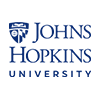
Johns Hopkins University
The Johns Hopkins University (commonly referred to as Johns Hopkins, JHU, or simply Hopkins) is a private research university in Baltimore, Maryland. Founded in 1876, the university was named for its first benefactor, the American entrepreneur, abolitionist, and philanthropist Johns Hopkins. His $7 million bequest — of which half financed the establishment of The Johns Hopkins Hospital — was the largest philanthropic gift in the history of the United States at the time. Daniel Coit Gilman, who was inaugurated as the institution’s first president on February 22, 1876, led the university to revolutionize higher education in the U.S. by integrating teaching and research.
The first research university in the Western Hemisphere and one of the founding members of the American Association of Universities, Johns Hopkins has ranked among the world’s top universities throughout its history. The National Science Foundation has ranked the university #1 among U.S. academic institutions in total science, medical, and engineering research and development spending for 31 consecutive years. Johns Hopkins is also tied for #12 in the U.S. News and World Report undergraduate program rankings.
Over the course of almost 140 years, 36 Nobel Prize winners have been affiliated with Johns Hopkins (the first was U.S. President Woodrow Wilson, who received his Ph.D. in history and political science from the university). Founded in 1883, the Blue Jays men’s lacrosse team has captured 44 national titles and joined the Big Ten Conference as an affiliate member in 2014.
Johns Hopkins is organized into ten divisions on campuses in Maryland and Washington, D.C. with international centers in Italy, China, Singapore, and Malaysia. The two undergraduate divisions, the Krieger School of Arts and Sciences and the Whiting School of Engineering, are located on the Homewood campus in Baltimore’s Charles Village neighborhood. The medical school, the nursing school, and the Bloomberg School of Public Health are located on the Medical Institutions campus in East Baltimore. The university also consists of the Peabody Institute, the Applied Physics Laboratory, the Paul H. Nitze School of Advanced International Studies, the education school, the Carey Business School, and various other facilities.
JHU’s Mission
To train, support and empower health care providers and health researchers in resource-limited communities
To demonstrate improved health outcomes in the communities served by our team and trainees
JHU’s Approach
Since founding in 2005, CCGHE has developed local partnerships in 20 countries. Responding to our partners’ health priorities:
We have leveraged the expertise of Johns Hopkins faculty and have collaborated with in-country experts to build needs-based educational programs delivered by world experts.
We have developed and pioneered the use of information communication technologies (ICT) to cost-effectively deliver interactive and self-paced distance-learning programs and innovative mobile Health (mHealth) applications to facilitate health care services, health education, and research activities.
Our faculty is collaborating with in-country scientists and Johns Hopkins partners to help prevent mother-to-child transmission of HIV, to reduce domestic violence, to optimize tuberculosis and HIV services, to make drinking water safer, to reduce the burden of chronic disease, to optimize health care delivery, and to evaluate health outcomes.
Our collaborative approach builds in-country expertise to independently develop educational programs, conduct top-notch research, and implement clinical support tools and distance learning infrastructure.
Our broad vision builds programs that include health care workers at all levels, such as nurses, midwives, physicians, laboratory technicians, pharmacists, health professional students, degree programs and a variety of front-line health workers, and content areas ranging from tuberculosis and HIV to surgical techniques and gender-based violence.
